Architecture

Many ancient standing stone monuments were erected during the prehistoric period, amongst the best known are Stonehenge, Devil's Arrows, Rudston Monolith and Castlerigg. With the introduction of Ancient Roman architecture there was a development of basilicas, baths, amphitheaters, triumphal arches, villas, Roman temples, Roman roads, Roman forts, stockades and aqueducts. It was the Romans who founded the first cities and towns such as London, Bath, York, Chester and St Albans. Perhaps the best known example is Hadrian's Wall stretching right across northern England Another well preserved example is the Roman Baths at Bath, Somerset. Early Medieval architecture's secular buildings were simple constructions mainly using timber with thatch for roofing. Ecclesiastical architecture ranged from a synthesis of Hiberno—Saxon monasticism, to Early Christian basilica and architecture characterised by pilaster-strips, blank arcading, baluster shafts and triangular headed openings. After the Norman conquest in 1066 various Castles in England were created so law lords could uphold their authority and in the north to protect from invasion. Some of the best known medieval castles include the Tower of London, Warwick Castle, Durham Castle and Windsor Castle amongst others.
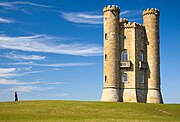
Throughout the Plantagenet era an English Gothic architecture flourished—the medieval cathedrals such as Canterbury Cathedral, Westminster Abbey and York Minster are prime examples.[196] Expanding on the Norman base there was also castles, palaces, great houses, universities and parish churches. Medieval architecture was completed with the 16th century Tudor style; the four-centred arch, now known as the Tudor arch, was a defining feature as were wattle and daub houses domestically. In the aftermath of the Renaissance a form of architecture echoing classical antiquity, synthesised with Christianity appeared—the English Baroque style, architect Christopher Wren was particularly championed. Georgian architecture followed in a more refined style, evoking a simple Palladian form; the Royal Crescent at Bath is one of the best examples of this. With the emergence of romanticism during Victorian period, a Gothic Revival was launched—in addition to this around the same time the Industrial Revolution paved the way for buildings such as The Crystal Palace. Since the 1930s various modernist forms have appeared whose reception is often controversial, though traditionalist resistance movements continue with support in influential places.
Folklore
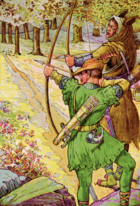
English folklore developed over many centuries. Some of the characters and stories are present across England, but most belong to specific regions. Common folkloric beings include pixies, giants, elfs, bogeymen, trolls, goblins and dwarves. While many legends and folk-customs are thought to be ancient, for instance the tales featuring Offa of Angeln and Weyland Smith,[199] others date from after the Norman invasion; Robin Hood and his Merry Men of Sherwood and their battles with the Sheriff of Nottingham being, perhaps, the best known.[200] During the High Middle Ages tales originating from Brythonic traditions entered English folklore—the Arthurian myth.[201][202][203] These were derived from Anglo-Norman, French and Welsh sources,[202] featuring King Arthur, Camelot, Excalibur, Merlin and the Knights of the Round Table such as Lancelot. These stories are most centrally brought together within Geoffrey of Monmouth's Historia Regum Britanniae. Another early figure from British tradition, King Cole, may have been based on a real figure from Sub-Roman Britain. Many of the tales and pseudo-histories make up part of the wider Matter of Britain, a collection of shared British folklore.

Some folk figures are based on semi or actual historical people whose story has been passed down centuries; Lady Godiva for instance was said to have ridden naked on horseback through Coventry, Hereward the Wake was a heroic English figure resisting the Norman invasion, Herne the Hunter is an equestrian ghost associated with Windsor Forest and Great Park and Mother Shipton is the archetypal witch.[205] On 5 November people make bonfires, set off fireworks and eat toffee apples in commemoration of the Gunpowder Plot centred around Guy Fawkes. The chivalrous bandit, such as Dick Turpin, is a recurring character, while Blackbeard is the archetypal pirate. There are various national and regional folk activities, participated in to this day, such as Morris dancing, Maypole dancing, Rapper sword in the North East, Long Sword dance in Yorkshire, Mummers Plays, bottle-kicking in Leicestershire, and cheese-rolling at Cooper's Hill.[206] There is no official national costume, but a few are well established such as the Pearly Kings and Queens associated with cockneys, the Royal Guard, the Morris costume and Beefeaters.
Cuisine
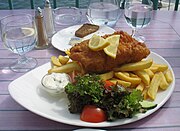
Since the Early Modern Period the food of England has historically been characterised by its simplicity of approach, honesty of flavour, and a reliance on the high quality of natural produce.[208] During the Middle Ages and through the Renaissance period, English cuisine enjoyed an excellent reputation, though a decline began during the Industrial Revolution with the move away from the land and increasing urbanisation of the populace. The French sometimes referred to English people as les rosbifs, as a stereotype to suggest English food is unsophisticated or crude. The cuisine of England has, however, recently undergone a revival, which has been recognised by the food critics with some good ratings in Restaurant's best restaurant in the world charts. An early book of English recipes is the Forme of Cury from the royal court of Richard II.
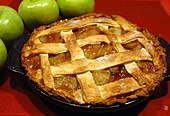
Traditional examples of English food include the Sunday roast; featuring a roasted joint, usually beef, lamb or chicken, served with assorted boiled vegetables, Yorkshire pudding and gravy.[212] Other prominent meals include fish and chips and the full English breakfast—consisting of bacon, grilled tomatoes, fried bread, black pudding, baked beans, fried mushrooms, sausages and eggs. Various meat pies are consumed such as steak and kidney pie, shepherd's pie, cottage pie, Cornish pasty and pork pie, the later of which is consumed cold.[212] Sausages are commonly eaten, either as bangers and mash or toad in the hole. Lancashire hotpot is a well known stew. Some of the most popular cheeses are Cheddar and Wensleydale. Many Anglo-Indian hybrid dishes, curries, have been created such as chicken tikka masala and balti. Sweet English dishes include apple pie, mince pies, spotted dick, scones, Eccles cakes, custard and sticky toffee pudding. Common drinks include tea, which became far more widely drunk due to Catherine of Braganza, while alcoholic drinks include wines and English beers such as bitter, mild, stout, and brown ale.
Visual arts
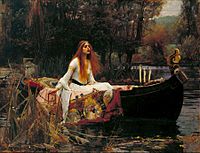
The earliest known examples are the prehistoric rock and cave art pieces, most prominent in North Yorkshire, Northumberland and Cumbria, but also feature further south, for example at Creswell Crags.[215] With the arrival of Roman culture in the 1st century, various forms of art utilising statues, busts, glasswork and mosaics were the norm. There are numerous surviving artefacts, such as those at Lullingstone and Aldborough. During the Early Middle Ages the style was sculpted crosses and ivories, manuscript painting, gold and enamel jewellery, demonstrating a love of intricate, interwoven designs such as in the Staffordshire Hoard discovered in 2009. Some of these blended Gaelic and Anglian styles, such as the Lindisfarne Gospels and Vespasian Psalter. Later Gothic art was popular at Winchester and Canterbury, examples survive such as Benedictional of St. Æthelwold and Luttrell Psalter.
The Tudor era saw prominent artists as part of their court, portrait painting which would remain an enduring part of English art, was boosted by German Hans Holbein, natives such as Nicholas Hilliard built on this. Under the Stuarts, Continental artists were influential especially the Flemish, examples from the period include—Anthony van Dyck, Peter Lely, Godfrey Kneller and William Dobson. The 18th century was a time of significance with the founding of the Royal Academy, a classicism based on the High Renaissance prevailed—Thomas Gainsborough and Joshua Reynolds became two of England's most treasured artists.[218] The Norwich School continued the landscape tradition, while the Pre-Raphaelite Brotherhood with their vivid and detailed style revived the Early Renaissance style—Holman Hunt, Dante Gabriel Rossetti and John Everett Millais were leaders. Prominent amongst twentieth century artists was Henry Moore, regarded as the voice of British sculpture, and of British modernism in general. Contemporary painters include Lucian Freud, whose work Benefits Supervisor Sleeping in 2008 set a world record for sale value of a painting by a living artist.
Literature, poetry and philosophy
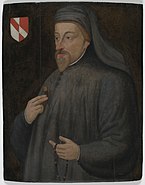
Early authors wrote in Latin such as Bede and Alcuin. While the period of Old English literature provided the epic poem Beowulf, the secular prose the Anglo-Saxon Chronicle, along with Christian writings such as Judith, Cædmon's Hymn and saintly hagiographies. Following the Norman conquest Latin continued amongst the educated classes, as well as an Anglo-Norman literature. Middle English literature emerged with Geoffrey Chaucer author of The Canterbury Tales, along with Gower, the Pearl Poet and Langland. Franciscans, William of Ockham and Roger Bacon were major philosophers of the Middle Ages. Julian of Norwich with her Revelations of Divine Love was a prominent Christian mystic. With the English Renaissance literature in the Early Modern English style appeared. William Shakespeare, whose works include Hamlet, Romeo and Juliet, Macbeth, and A Midsummer Night's Dream, remains one of the most championed authors in English literature. Marlowe, Spenser, Sydney, Kyd, Donne, Jonson are other established authors of the Elizabethan age. Francis Bacon and Thomas Hobbes wrote on empiricism and materialism, including scientific method and social contract.[224] Filmer wrote on the Divine Right of Kings. Marvell was the best known poet of the Commonwealth, while John Milton authored Paradise Lost during the Restoration.
| This royal throne of kings, this sceptred isle, this earth of majesty, this seat of Mars, this other Eden, demi-paradise; this fortress, built by nature for herself. This blessed plot, this earth, this realm, this England. —William Shakespeare.[226] |
Some of the most prominent philosophers from the Enlightenment were Locke, Paine, Johnson and Benthem. More radical elements were later countered by Edmund Burke who is regarded as the founder of conservatism. The poet Alexander Pope with his satirical verse became well regarded. The English played a significant role in romanticism—Coleridge, Byron, Keats, M Shelley, PB Shelley, Blake and Wordsworth were major figures. In response to the Industrial revolution, agrarian writers looked to find a way between liberty and tradition; Cobbett, Chesterton and Belloc were main exponents, while founder of guild socialism, Penty and cooperative movement advocate Cole are somewhat related. Empiricism continued through Mill and Russell, while Williams was involved in analytics. Authors from around the time of the Victorian era include Dickens, the Brontë sisters, Austen, Kipling, Wells, and Underhill. Since then England has continued to produce novelists such as C. S. Lewis, Orwell, Blyton, Christie, Tolkien, and J. K. Rowling.

No comments:
Post a Comment